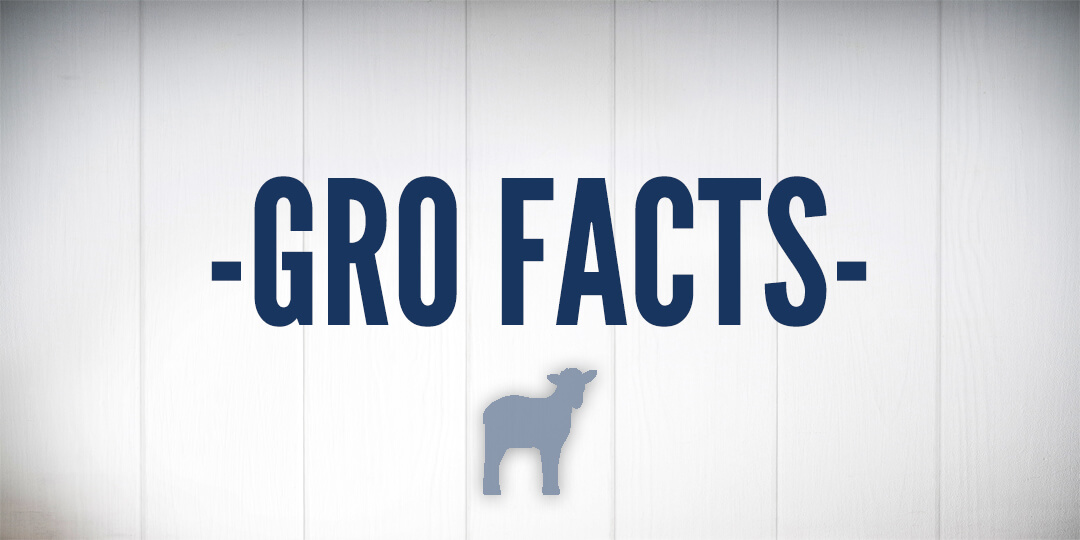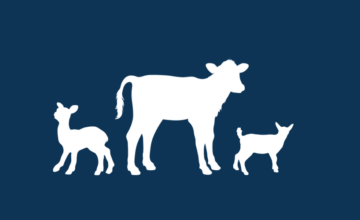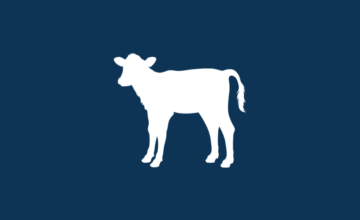Lamb Survival
- Mar 09, 2009
- By Grober Nutrition
- In Canada, USA
Profitability in sheep farming is largely dependant on the number of lambs weaned per ewe each year. Typically, the lambs weaned for each ewe exposed to a ram should be at least 2 or more. Lamb survival is a result of good ewe management before and during lambing and attention to early care of lambs.
Preparation tips for successful lambing and weaning:
Lambing date
Knowledge of lambing dates is important to ensure that ewes are managed appropriately to ensure successful lambing. Preparation of buildings and an emergency ‘nursery’ will help with the survival of small, weaker lambs and for the optimal growth of lambs from multiple births.
Ewe nutrition
The fittest lambs are born to ewes that have been maintained correctly from pre-mating to lambing. Weight gain usually occurs in the premating phase and is then followed by a constant weight maintenance (condition score 2.5-3) between days 50-90 of pregnancy. Ewes that are in prime condition at mating maximize egg production, show increased conception rate and egg survival. It is not desirable to have ewes on a high level of nutrition post mating as the higher rate of metabolism removes progesterone from the blood stream more quickly. Progesterone is essential for embryo survival and development. Sudden changes in diet in the first 3 weeks after mating can also effect embryo survival. Under feeding may increase the likelihood of more single births rather than multiple births. Inadequate feeding during mid pregnancy results in small birth weight lambs. Nutrition needs increase significantly in the last 4-6 weeks of pregnancy. It is important to support rapid fetal growth (70% of growth occurs in last 6 weeks) and udder development for colostrum and milk production. If the high demands are not met, pregnancy toxemia/twin lamb disease can result. Body condition score at lambing should be 3-3.5. Ewes that are fat are prone to vaginal prolapse. These factors should be considered for the next lamb crop alongside light (photoperiod) management.
Ewe management at lambing
Lambing pens with clean, dry bedding (for each ewe) should always be available. Pens should be about 1.5m square with a corner divided off to give the lamb a safe area. Each ewe can expect to spend 1-2 days in this pen. A ‘normal’ delivery takes about 5 hours from dilation of the cervix (4 hours) and delivery (1 hour). Once the lamb is born, ensure that it starts breathing. Clean mucus away from the nose and mouth. The lamb should be encouraged to nurse as soon as possible to maximize absorption of Immunoglobulins (Ig’s) from colostrum. Weak lambs may need to be tube fed. Observe lambs carefully to ensure they are feeding correctly, regularly and do not become chilled. This is especially important for multiple births.
Management of multiple birth and orphan lambs
The greatest proportion of lamb deaths is caused by a combination of chilling (hypothermia) and starvation. It can account for the death of about 30% of lambs born alive and occurs within the first 3 weeks of life. Lambs with the greatest risk of becoming hypothermic include: small and premature lambs, lambs which are weak and limp at birth, lambs from ewes in poor condition, lambs from very old or very young ewes, lambs born into a cold, wet, windy environment, twins and especially triplets The newborn lamb’s ability to produce heat is proportional to its bodyweight. Heat loss is influenced by several external factors: Body surface area: body weight ratio – a small lamb has a larger surface area in proportion to its weight and therefore will chill faster than a larger lamb. Insulation from the coat – breed differences and dryness of coat Heat loss (kcalm-1h-1) always decreases when the temperature (°C) increases irregardless of the weather conditions. This chart shows the effect of wind, environmental temperature and wetness on heat loss in newborn lambs. [From Alexander, G. (1962), Australian Journal of Agricultural Research, 13, 82-99.] Energy (fat) reserves in lambs are only 3% of BW compared to 10-15% in adults. Lambs require adequate colostrum and brown fat (type of fat born with) to help maintain body heat. A lambs brown fat reserves will be used within 3 days after birth. Starvation/ Hypothermia Risk Action Chilling reduces the suckling drive Ensure lamb is provided a warm, dry, wind free environment Select breed or cross suitable for conditions and type of operation. Low milk intake increases the lamb’s susceptibility to cold Ensure lamb is suckling and ewe is providing sufficient milk Insufficient feed/ energy intake reduces ability to generate heat Ensure lamb is provided with and consumes adequate good quality colostrum Provide a high quality milk replacer ‘Lamb-Gro’ if lamb is orphaned or not getting sufficient milk from ewe, e.g. multiple birth lambs.
Colostrum: What does it provide the newborn lamb?
- Nutrients (high fat%) to provide heat production and help prevent hypothermia
- Immunoglobulins (Ig’s) to help prevent infection. Some line the gut wall and the rest are absorbed into the bloodstream, as long as provided within the first 24 hours following birth. The most efficient IgG absorption period is in the first few hours after birth.
- Growth factors to promote gut growth and differentiation especially during the first 24-48 hours after birth.
How much does a lamb need?
- 50ml/kg body weight right at birth and every 6 hours for the first 24 hours. E.g. 4kg lamb receives 800ml (3 1/3 cups) The amount should be increased by 20-30% for lambs exposed to undesirable weather, this is equal to one extra feeding.
- Colostrum yield from ewes can be variable and low especially if the ewe has been underfed or is in poor conditions.
- It is ideal to use colostrum from the mother. If not possible, then use pooled ewe colostrum from same flock, then pooled ewe colostrum from another flock (same disease status), then cow colostrum (30% more via one extra feed), then artificial colostrum.
Why is colostrum so important?
The Ig’s in colostrum provide a passive protection of the newborn lamb until its own immune system is functioning. The newborn lamb does not have any antibodies at birth as they do not cross the placenta from the ewe’s bloodstream. Some primary disease causing agents of lambs include Ecolab, Rotavirus and Cryptosporidia. The newborn gut does not have the acidity or ability to help destroy these harmful bacteria. Viral agents can cause severe damage to the small intestine of young ruminants that will adversely affect their future performance. Vaccinating ewes for diseases at 5 weeks (ewe lambs) and/or 3 weeks (mature ewes) prior to lambing enables antibodies against these specific common diseases to be produced and passed to the lamb via the ewe’s colostrums, (e.g. E.coli, Tetanus, Clostridia gp). Excess colostrum can be collected from high yielding ewes and frozen for up to one year and used at a later date.
Choosing lambs for artificial rearing
Prolific ewes produce more lambs than their milk production can sustain, at adequate growth rates. Extra lambs are best removed entirely from the dam. It is best to remove the lamb most different in size and then gender. Lambs should be grouped according to size and then gender. Lambs should only be moved to a new group once they have achieved a target weight. This ensures that weaker, smaller lambs are provided the extra attention and smaller group size until strong enough to compete.
Methods of feeding milk replacer
There are many techniques for feeding milk replacer to orphan or multiple birth lambs. The choice of system depends on the number of lambs’ to be reared, individual preference, buildings etc. Lambs should ideally be raised in a room at 15-18ºC. High sanitation is critical for all systems. Correct disinfection of mixing and feeding equipment will help prevent the proliferation of bloat and scour causing organisms. It is important to follow the manufacturer instructions for mixing and also feeding rate according to average size of lamb fed. Limit feeding (set amount of milk 3-4 times a day): ideal for small numbers of lambs. Milk is fed via a nipple on a bottle or nipple pail (one nipple per lamb). It is labour intensive but can allow a reduced cost of the milk feeding period with an easier transition to solid feed and easier weaning. Milk should be fed at 38-40°C (body temperature). Free choice feeding (warm or cool (4ºC) but not excessively cold): Typical systems include, nipple pail units, teat bars and commercial automatic feeders (e.g. Forster). Lambs have access to milk at all times and are group fed. The milk supply must not be allowed to run out as lambs will easily over feed with new milk. Milk fed at 4ºC will be consumed in smaller amounts more often. This reduces digestive upsets from overeating. In warm/hot weather, milk can be kept cold by floating a clean plastic (pop) bottle filled with frozen water in the milk replacer. Formalin may also be added to free choice milk (1ml/litre milk replacer solution) to prevent microbe growth. It also tends to restrict gorging due to it’s unpleasant taste. Be careful that lambs do not completely reject the milk. Each nipple can accommodate 5-6 lambs and must be 40-45cm (16-18ins) above the stall floor. Lambs may require assistance in adapting to nipples for 1-2 days. Free choice feeding can minimize labour but disease transfer may be higher. Lambs can easily chew nipples which can result in milk replacer loss from the container. Free choice feeding results in higher feed intakes. Which encourage greater gains and therefore allows for an earlier weaning period. Commercial automatic feeders can feed 50-150 lambs per unit and so are ideal for dairy sheep operations or prolific breeds on accelerated systems. After about 10 days, larger groups can be formed and 10-25 lambs can feed off one nipple. Consult machine supplier for advice.
Feeding lambs in cold conditions
Ensure lamb feeding equipment is protected from extreme environmental conditions to prevent large temperature variation and freezing of milk in pipes and container. Provide lambs adequate milk to maintain positive energy balance and growth performance. Cold conditions can be a result of, or combination of, reduced air temperatures, higher humidity, wet bedding etc. When lambs reach negative energy balance, immune status can be easily compromised and the lambs become more susceptible to disease.
Milk sheep
Feeding a quality milk replacer to lambs from milking ewes can increase marketable milk and also may improve total milk lactation production. The regular full draw on the ewe maintains a maximal milk synthesis. If lambs are left on the ewe and do not take a full milking, then milk production declines and will not recover once lamb is removed.
Weaning
Lambs are usually weaned from 21-45 days of age (average 30 days) and 12kg bodyweight. Lambs should be consuming a minimum of 120-150g of creep ration per day for more than 2 consecutive days and have consumed a minimum of 8-10kg of milk replacer.
Typical disease pathogens for lambs:
- Watery mouth – infection with E.coli precipitated by chilling, stress and/or lack of colostrum intake. This typically occurs during the first few days of life and up to six weeks of age. Young lambs salivate and become distressed with a distended abdomen. The lambs can also scour which can lead to dehydration and even death. This condition can last in lambs for up to 10 days.
- Scours – inflammation of intestine from infectious disease pathogens such as E.coli, Cryptosporidia, Rotavirus and lamb dysentery (clostridia).
- Pneumonia -dust, ammonia buildup, extreme weather changes (especially in humidity levels), etc. can encourage pneumonia. Pneumonia is often fatal or resulting lung damage will affect future health and productivity.
- Internal Parasites- one of the biggest health problems in grazing lambs.
Checklist:
As soon as lamb is born ensure adequate colostrum intake by suckling, bottle or stomach tube Identify premature, underweight, starving, cull ewe lambs and ensure adequate milk intake and warmth. Ensure good sanitation practices; maintaining barns with good ventilation, dry, no drafts, and strict cleaning of lambing premises. Group lambs according to age and body weight and supply sufficient nipples. (e.g. 5-6 lambs /nipple at start and increase to 10-25 lambs/nipple dependant on machine and space etc) Monitor lambs closely and regularly for signs of ill health or starvation. Treat as soon as possible. Early rumen development will be accomplished by supplying a highly palatable and nutritious creep feed as soon as possible. Offer hay and clean, fresh water at all times.
- Grober milk replacers are manufactured to the highest standards.
- Grober research and on farm testing ensures the best nutritional products available for lamb growth and development.
- Grober LambGro and good management provide a strong foundation for growth and production of lambs.
- Grober ECO Automatic Feeders availabile from Grober Nutrition or your local dealer.
Grober Nutrition
Recent Posts
Tags
Archives
- April 2024
- January 2024
- December 2023
- October 2023
- September 2023
- August 2023
- June 2023
- December 2022
- November 2022
- October 2022
- August 2022
- July 2022
- June 2022
- May 2022
- April 2022
- March 2022
- February 2022
- January 2022
- August 2021
- February 2021
- September 2020
- June 2020
- April 2020
- May 2017
- April 2017
- October 2016
- September 2016
- August 2016
- March 2016
- March 2015
- January 2015
- December 2014
- December 2013
- September 2013
- May 2013
- January 2013
- December 2012
- November 2012
- March 2012
- March 2011
- February 2011
- November 2010
- August 2010
- December 2009
- November 2009
- March 2009






